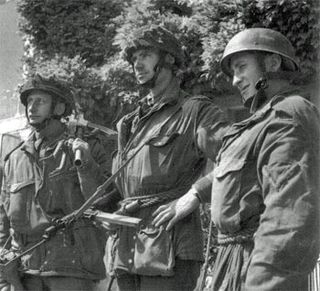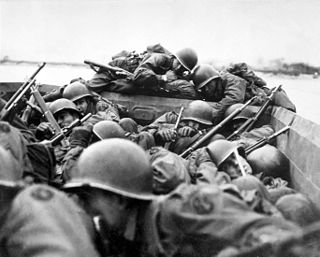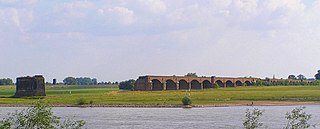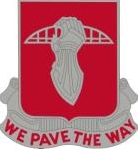
The 8th Armored Division was an armored division of the United States Army that served in the European Theater of World War II.

The 17th Airborne Division, "The Golden Talons", was an airborne infantry division of the United States Army during World War II, commanded by Major General William M. Miley.

The 6th Airborne Division was an airborne infantry division of the British Army during the Second World War. Despite its name, the 6th was actually the second of two airborne divisions raised by the British Army during the war, the other being the 1st Airborne Division. The 6th Airborne Division was formed in the Second World War, in mid-1943, and was commanded by Major-General Richard N. Gale. The division consisted of the 3rd and 5th Parachute Brigades along with the 6th Airlanding Brigade and supporting units.

Operation Plunder was a military operation to cross the Rhine on the night of 23 March 1945, launched by the 21st Army Group under Field Marshal Bernard Montgomery. The crossing of the river was at Rees, Wesel, and south of the river Lippe by the British Second Army under Lieutenant General Miles Dempsey, and the United States Ninth Army under Lieutenant General William H. Simpson.

The 83rd Infantry Division ("Thunderbolt") was a formation of the United States Army in World War I and World War II.

The 30th Infantry Division was a United States Army unit of the National Guard that served in World War I and World War II. It was nicknamed the "Old Hickory" division, in honor of President Andrew Jackson. The Germans nicknamed this division "Roosevelt's SS". The 30th Infantry Division, involved in 282 days of intense combat over a period from June 1944 through April 1945, was regarded by a team of historians led by S.L.A. Marshall as the American infantry division that had "performed the most efficient and consistent battle services" in the European Theater of Operations (ETO). In the present day, the division's lineage continues as 30th Armored Brigade Combat Team, part of the North Carolina National Guard. The unit's most recent combat deployment was in 2019.

The 79th Armoured Division was a specialist armoured division of the British Army created during the Second World War. The division was created as part of the preparations for the Normandy invasion on 6 June 1944, D-Day.

The 507th Parachute Infantry Regiment, now the 507th Infantry Regiment, is an airborne infantry regiment of the United States Army. The regiment was initially assigned to the 82nd Airborne Division in World War II before transferring to the 17th Airborne Division. Now 1st Battalion, 507th Infantry Regiment is part of the United States Army Infantry School, subordinate to its Airborne and Ranger Training Brigade, responsible for the Army's Basic Airborne School, Jumpmaster School, Pathfinder School, and the "Silver Wings" Command Exhibition Parachute Team.

The 11th Armoured Division was an armoured division of the British Army which was created in March 1941 during the Second World War. The division was formed in response to the unanticipated success of the German panzer divisions. The 11th Armoured was responsible for several major victories in the Battle of Normandy from in the summer of 1944, shortly after the Normandy landings, and it participated in the Allied advance from Paris to the Rhine, the Rhine crossing in March 1945. It was disbanded in January 1946 and reformed towards the end of 1950. In 1956, it was converted into the 4th Infantry Division.

The 1st Canadian Parachute Battalion was an airborne infantry battalion of the Canadian Army formed in July 1942 during the Second World War; it served in North West Europe, Landing in Normandy during Operation Tonga, in conjunction with the D-Day landings of 6 June 1944 and in the airborne assault crossing of the River Rhine, Operation Varsity, in March 1945. After the end of hostilities in Europe, the battalion was returned to Canada where it was disbanded on 30 September 1945.

The Engineer Special Brigades were brigade-sized amphibious forces of the United States Army developed during World War II and active from 1942 to 1955. Initially designated engineer amphibian brigades, they were redesignated engineer special brigades in 1943. The 1st, 5th, and 6th Engineer Special Brigades were assigned to the European Theater of Operations. The 1st Engineer Special Brigade participated in the landings in Sicily and Italy before joining the 5th and 6th Engineer Special Brigades for the invasion of Normandy.

The Wesel Railway Bridge was a bridge on the Haltern–Venlo railway, built as part of the Hamburg–Venlo railway by the Cologne-Minden Railway Company, and opened on 1 March 1874. The 1,950-metre (6,400 ft) long railway bridge at Wesel was the last Rhine bridge remaining in German hands during World War II.

The 17th Armored Engineer Battalion was a part of the 2nd Armored Division "Hell on Wheels". During World War II, they were active in North African Campaign, and Western Europe Campaign. 17th Armored Engineer Battalion was founded on 1 October 1933 as part of the US Army. First called 17th Engineer Battalion, Motorized. It was renamed on 10 July 1940 to 17th Engineer Battalion (Armored) and assigned to the 2nd Armored Division. The unit became active and started training 15 July 1940 at Fort Benning, Georgia. Renamed again on 8 January 1942 as the 17th Armored Engineer Battalion. The Battalion is now based at Fort Cavazos, Texas. The battalion's motto was We pave the way. Tasks of the 17 included construction and demolition under combat conditions, constructing and breaching trenches, tank traps and other fortifications, bunker construction, bridge and road construction, and building destruction bridges and other physical work in the battlefield whenever needed. They also laid and cleared land mines. The 17th facilitated the movement and support of friendly forces while slowing down the enemy's forces.

The 291st Engineer Combat Battalion was one of the most decorated engineer combat battalions of the United States Army during World War II, playing notable roles both in the Battle of Bulge and the Rhine river crossing at Remagen.

The 289th Engineer Combat Battalion was a combat engineer battalion of the United States Army during World War II. It served under XXI Corps of the Seventh Army in action mainly in France and Germany in 1944 and 1945. It received campaign credit for participation in the Ardennes-Alsace campaign , Rhineland campaign, and the Invasion of Germany.

The 194th Glider Infantry Regiment was a Glider infantry regiment of the United States Army that served in World War II. It was a part of the 17th Airborne Division, and saw active combat service until its deactivation in 1945.
The 655th Engineer Topographic Battalion was a technical support unit formed to provide surveying, drafting, and map production activities for the US Army during World War II. With the beginning of the war in Europe, the U.S. realized that the existing European maps were inadequate for tactical purposes or use by artillery units, since existing map grids were inconsistent and did not match up between countries. The Engineer Topographic Battalion's wartime mission was the development of accurate 4-color topographic maps created through timely survey work, drafting, printing, and distribution of military maps as required by the Allied Armed Forces of the United States. The Battalion was first formed in December 1943 and deactivated in December 1946.

Camp Bouse was a secret camp of the US Army, Desert Training Center in Mohave County, Arizona. Camp Bouse is located 25 miles (40 km) from Bouse, Arizona, just north of Arizona State Route 72 and about 50 miles (80 km) north of Interstate 10.

The 1139th Engineer Combat Group was a technical United States Army Headquarters Unit providing administration and supervision support to Combat Engineers on bridge building and other construction activities during World War II. The 1139th Engineer Combat Group was part of the Third Army and was attached for operations to the XX Corps in direct support of the 7th Armored Division. The 1139th Engineer Combat Group fought from northern France to Austria in World War II, supporting General George Patton's Third Army's rapid movements during the war.

American logistics in the Western Allied invasion of Germany supported the American and French operations in Northwest Europe during the Second World War from 26 January 1945 until the end of World War II in Europe on 8 May 1945.























